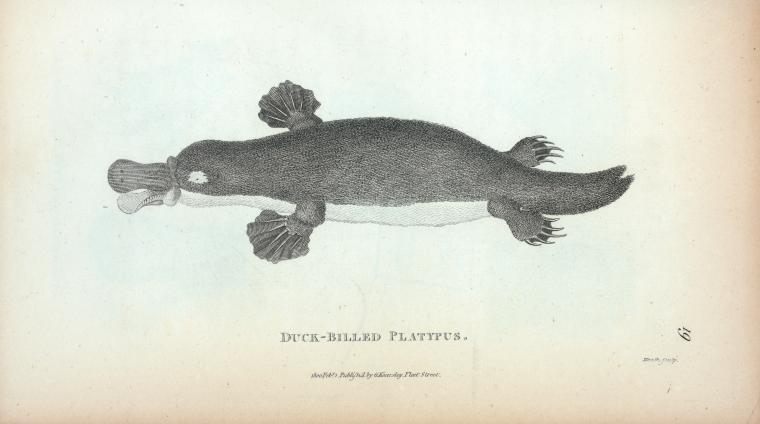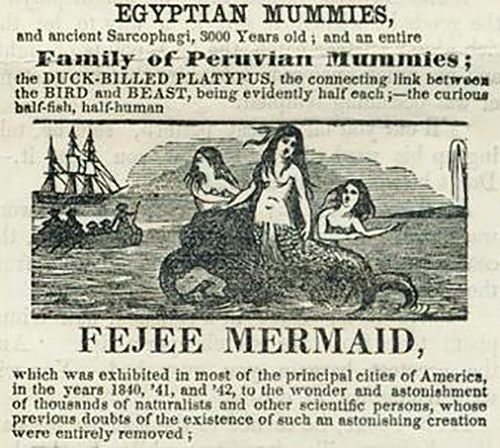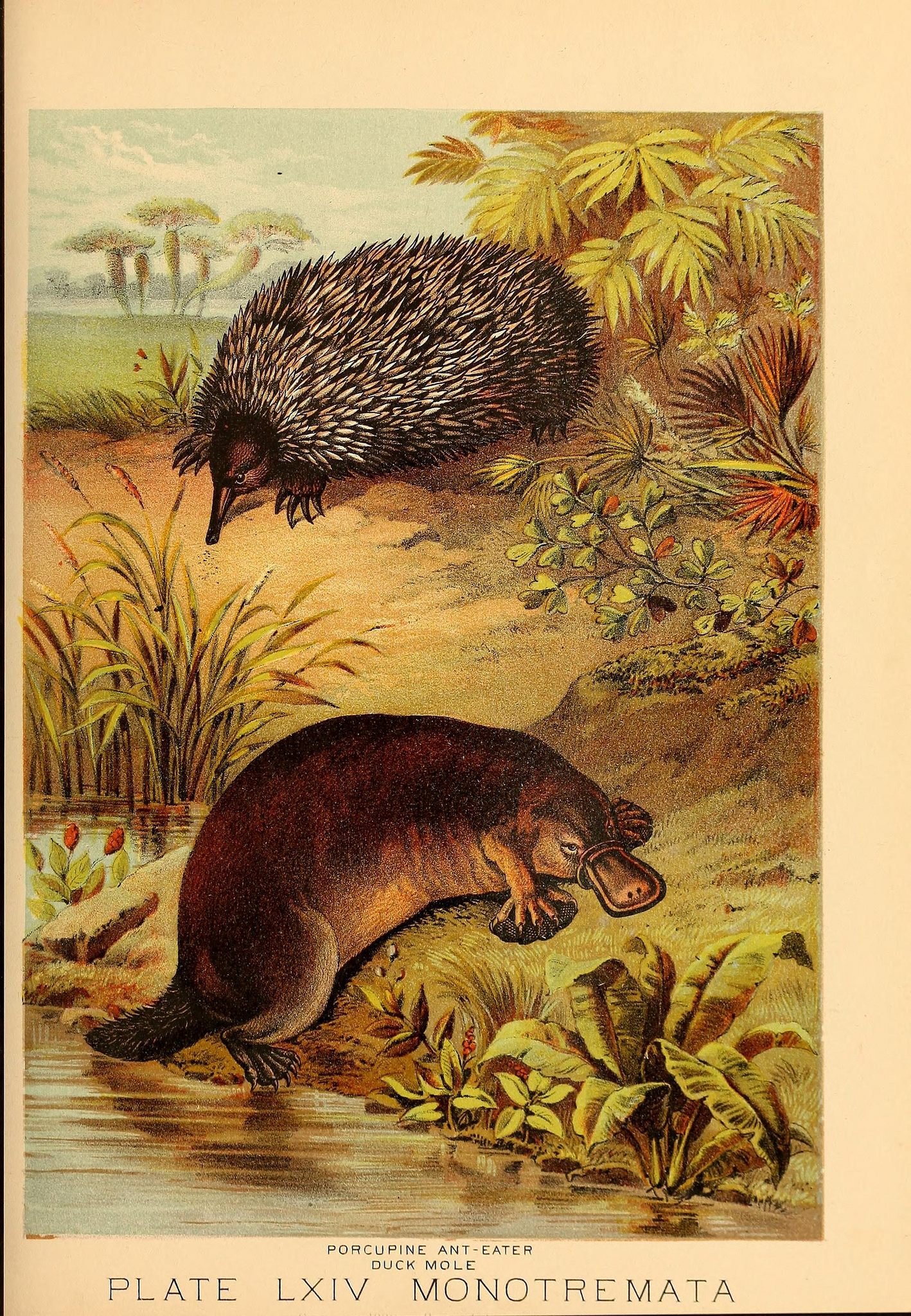Why 19th-Century Naturalists Didn’t Believe in the Platypus
Scientists argued for 90 years about the animal’s freaky looks.

George Shaw’s depiction of a duck-billed platypus from 1809. (Photo: New York Public Library)
In his laboratory study in 1799, biologist George Shaw stared down at his new specimen in disbelief. The creature from the colony of New South Wales came preserved in pungent alcohol, and he carefully snipped the thick, brown pelt around the creature’s beak, sure he would soon reveal the stitches where an expert taxidermist had fused the bird and beast together. It was like nothing he had seen before: the creature had the body of a furry brown cat, four short legs and sharp claws over webbed feet; the tail of a beaver, but the beak of a duck.
Shaw had met his first platypus, and did not for a moment believe it was possibly real. Still, he couldn’t find any evidence that it was a fake, either. That year in his book The Naturalist’s Miscellany, he described it as having the “perfect resemblance of the beak of a duck…grafted on the head of a quadruped.” Such an animal “naturally excites the idea of some deceptive preparation by artificial means,” he confessed.

The scientific world was moving through a new, exciting age of discovery and debate. Biologists in Europe were close to developing a classification system for animals, and theories on how those animals came to be were brewing. The platypus, with its flexible beak and venomous spurs, was a crowbar in the gear-work of known science, causing debates that would not be resolved for 90 years.

George Shaw. (Photo: Public Domain)
Shaw’s suspicions were understandable; the 18th-century scientific community had been burned a few times. Right before entomologist William Charlton died in 1702, he sent in a new species of butterfly, which Carl Linnaeus would later include in his influential Systema Naturae. The scientific community accepted Charlton’s discovery until 1793, when another entomologist discovered ink marks carefully placed on its wings.
In 1725 Dr. Johann Beringer was tricked by local boys into collecting over 2,000 false fossils and publishing them in a book before he realized he was subject to a hoax. What’s more, fishermen had been buying expertly sewn monkey-and-fish taxidermy creations from East Asian artists for years, one of which became P.T. Barnum’s famed Feejee Mermaid just a few decades later.

An 1842 advertisement for P.T Barnum’s “Feejee Mermaid”, and also “the Duck-billed Platypus, the connecting link between the bird and beast”. (Photo: Public Domain)
Even two decades later scientists weren’t convinced that the creature was legit; anatomist Robert Knox announced that the platypus was a “freak imposture”, and that ”the scientific [community] felt inclined to class this rare production of nature with eastern mermaids and other works of art.” The veracity of this “amphibious creature of the mole kind,” as New South Wales colonist David Collins described the animal in 1797, would be in doubt for many more decades.
The animals kept sailing in from the colonies, but even after biologists agreed the platypus was real, no one knew what to think of it. What was it, exactly? A creepy, furry reptile? A mammal-bird? And what allows such a creature to exist in the first place?

A platypus depicted as a “duck mole” from the 1880 title Johnson’s Household Book of Nature. (Photo: Biodiversity Heritage Library/CC BY 2.0)
According to Ann Moyal’s book Platypus, theories about the platypus developed even before specimens were shipped from Australia to Europe. Soon after setting sight on the animal in 1793, Australian Governor John Hunter declared that “a promiscuous intercourse between the different sexes of all these different animals” might be how the platypus had come to be. Charles Darwin’s grandfather Dr. Erasmus Darwin used this quote to bolster his budding statement of evolution in his 1796 book, Zoomania.
Australia began sending platypus organs preserved in alcohol to Europe in alarming numbers. An article in International Science and National Scientific Identity writes that, “Literally thousands of preserved and stuffed platypus and their uteri were shipped back to Britain for research. It’s a miracle they still survive today after such slaughter.”
Anatomists of the time needed to know how to classify this animal, and of course this provoked arguments too. While looking at his plentiful platypus organs, British anatomist Everard Home of the Royal College of Surgeons in London found that the beak was actually a sensory apparatus, and that the platypus’s sexual organs were like those of an oviparous reptile. Home believed the platypus had to be a new kind of mammal more closely related to birds, while others insisted it was a mammal. Anatomist J. K. W. Illiger deftly placed it in a new class called Reptantia. Jean Baptiste-Lamarck insisted it was a new non-mammal, and called its class Prototheria.

George Shaw’s illustration of the beak and feet of the platypus. (Photo: New York Public Library)
Lamarck had already introduced the idea of transmutationism, a controversial early theory of evolution that said new creatures formed through adaptation, and ideas about how the platypus fit into this bounced aggressively off university walls. Anti-transmutationists of the mid-1800s felt these ideas were too simplistic for the platypus. Biologist and anti-transmutationist Richard Owen believed platypuses were mammals that gave birth through eggs which developed viviparously, and particularly disliked that transmutationist Etienne Geoffrey Saint-Hilaire put the platypus into a new, transitional class called Monotremata.
Charles Darwin was also intrigued at the platypus’s existence, and seeing it in a 1836 excursion to Australia may have inspired him to connect his own thoughts on evolution. Smithsonian reports that Darwin’s descendant, Chris Darwin, was told from a young age about the “platypus moment,” a factor that made the influential scientist “question creationism for the first time” while in Australia.
More than three decades after it was first described, biologists were still unsure if the platypus laid eggs or gave birth and nursed, which would dictate its classification. Even more complicated was that the female platypus has no teats to nurse her young—it wouldn’t be until 1833 that biologist George Bennett went to Australia and discovered that the animals do indeed nurse—the female platypus actually secretes milk from its pores, which pool into ridges on the platypus abdomen like little milk dishes for her young.

A platypus in the wild, in Tasmania. (Photo: Klaus/CC BY-SA 2.0)
In the late 1800s, Scottish zoologist William Hay Caldwell finally managed to dissect fresh platypus eggs and confirmed once and for all that the animal did in fact lay them, though the embryos partially developed inside the platypus’s body, which also nursed its young. The platypus was classified as a mammal—one of five that are known to lay eggs, in the order Monotremata.
The platypus is no longer a source for constant debate, but the weird little creature still has a lot to teach. In fact, revisiting platypus genetics is helping biologists learn about the evolution of Ribonucleic acid (RNA), and how mammals began to pass XY chromosomes–the platypus, like birds, have multiple X’s and Y’s versus the mammalian single pair. In 2010, the 80 toxins of the platypus’ venomous spurs were discovered to have come from separate animal lineages. And in 2013, a giant ancient platypus tooth was found, which might rearrange some of what was thought about the platypus’ evolution before.
While some members of the public might like to see it, the original platypus specimen given to Shaw is now too delicate to be exhibited. Shaw’s original, skeptical cut marks are still visible on its pelt, though, which spends its afterlife in a box in the “Mammal Tower” of London’s Natural History Museum.





















Follow us on Twitter to get the latest on the world's hidden wonders.
Like us on Facebook to get the latest on the world's hidden wonders.
Follow us on Twitter Like us on Facebook